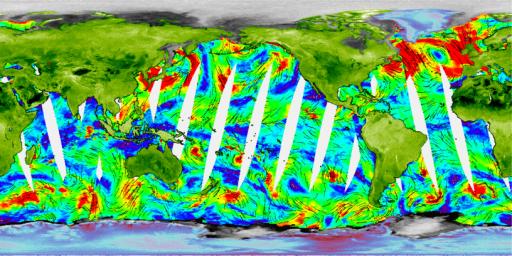One of NASA's newest Earth-observing instruments, the SeaWinds scatterometer aboard Japan's Advanced Earth Observing Satellite (Adeos) 2--now renamed Midori 2--has successfully transmitted its first radar data to our home planet, generating its first high-quality images.
From its orbiting perch high above Earth, SeaWinds on Midori 2 ('midori' is Japanese for the color green, symbolizing the environment) will provide the world's most accurate, highest resolution and broadest geographic coverage of ocean wind speed and direction, sea ice extent and properties of Earth's land surfaces. It will complement and eventually replace an identical instrument orbiting since June 1999 on NASA's Quick Scatterometer (QuikScat) satellite. Its three- to five-year mission will augment a long-term ocean surface wind data series that began in 1996 with launch of the NASA Scatterometer on Japan's first Adeos spacecraft.
Climatologists, meteorologists and oceanographers will soon routinely use data from SeaWinds on Midori 2 to understand and predict severe weather patterns, climate change and global weather abnormalities like El Niño. The data are expected to improve global and regional weather forecasts, ship routing and marine hazard avoidance, measurements of sea ice extent and the tracking of icebergs, among other uses.
'Midori 2, its SeaWinds instrument and associated ground processing systems are functioning very smoothly,' said Moshe Pniel, scatterometer projects manager at NASA's Jet Propulsion Laboratory, Pasadena, Calif. "Following initial checkout and calibration, we look forward to continuous operations, providing vital data to scientists and weather forecasters around the world."
"These first images show remarkable detail over land, ice and oceans," said Dr. Michael Freilich, Ocean Vector Winds Science Team Leader, Oregon State University, Corvallis, Ore. "The combination of SeaWinds data and measurements from other instruments on Midori 2 with data from other international satellites will enable detailed studies of ocean circulation, air-sea interaction and climate variation simply not possible until now."
The released image, obtained from data collected January 28-29, depicts Earth's continents in green, polar glacial ice-covered regions in blue-red and sea ice in gray. Color and intensity changes over ice and land are related to ice melting, variations in land surface roughness and vegetation cover. Ocean surface wind speeds, measured during a 12-hour period on January 28, are shown by colors, with blues corresponding to low wind speeds and reds to wind speeds up to 15 meters per second (30 knots). Black arrows denote wind direction. White gaps over the oceans represent unmeasured areas between SeaWinds swaths (the instrument measures winds over about 90 percent of the oceans each day).
SeaWinds transmits high-frequency microwave pulses to Earth's land masses, ice cover and ocean surface and measures the strength of the radar pulses that bounce back to the instrument. It takes millions of radar measurements covering about 93 percent of Earth's surface every day, operating under all weather conditions, day and night. Over the oceans, SeaWinds senses ripples caused by the winds, from which scientists can compute wind speed and direction. These ocean surface winds drive Earth's oceans and control the exchange of heat, moisture and gases between the atmosphere and the sea.
Launched December 14, 2002, from Japan, the instrument was first activated on January 10 and transitioned to its normal science mode on January 28. A four-day dedicated checkout period was completed on January 31. A six-month calibration/validation phase will begin in April, with regular science operations scheduled to begin this October.
SeaWinds on Midori 2 is managed for NASA's Office of Earth Science, Washington, D.C., by JPL, which developed the instrument and performs instrument operations and science data processing, archiving and distribution. NASA also provides U.S. ground system support. The National Space Development Agency of Japan, or NASDA, provided the Midori 2 spacecraft, H-IIA launch vehicle, mission operations and the Japanese ground network. The National Oceanic and Atmospheric Administration provides near-real-time data processing and distribution for SeaWinds operational data users. The California Institute of Technology in Pasadena manages JPL for NASA.

 Planetary Data System
Planetary Data System












